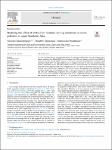Item Infomation

| Title: | Modeling the effect of VOCs from biomass burning emissions on ozone pollution in upper Southeast Asia |
| Authors: | Amnuaylojaroen, Teerachai |
| Participants: | Macatangay, Ronald C. Khodmanee, Suratsawadee |
| Issue Date: | 2019 |
| Publisher: | Elsevier |
| Series/Report no.: | Heliyon,Volume 5, Issue 10 |
| Abstract: | We used a Weather Research and Forecasting Model with Chemistry (WRF-CHEM) model that includes anthropogenic emissions from EDGAR-HTAP, biomass burning from FINN, and biogenic emissions from MEGAN to investigate the main volatile organic compound (VOC) ozone precursors during high levels of biomass burning emissions in March 2014 over upper Southeast Asia. A comparison between the model and ground-based measurement data shows that the WRF-CHEM model simulates the precipitation and 2 m temperature reasonably well, with index of agreement (IOA) values ranging from 0.76 to 0.78. Further, the model predicts O3, NO2, and CO fairly well, with IOA values ranging from 0.50 to 0.57. However, the magnitude of the simulated NO2 concentration was generally underestimated compared to OMI satellite observations. The model result shows that CO and VOCs such as BIGENE play an important role in atmospheric oxidation to surface O3. In addition, biomass burning emissions are responsible for increasing surface O3 by ∼1 ppmv and increasing the reaction rate of CO and BIGENE by approximately 0.5 × 106 and 1 × 106 molecules/cm3/s, respectively, in upper Southeast Asia. |
| URI: | http://tailieuso.tlu.edu.vn/handle/DHTL/8364 |
| ISSN: | 2405-8440 |
| Appears in Collections: | Tài liệu hỗ trợ nghiên cứu khoa học |
ABSTRACTS VIEWS
296
VIEWS & DOWNLOAD
36
Files in This Item:
Bạn đọc là cán bộ, giáo viên, sinh viên của Trường Đại học Thuỷ Lợi cần đăng nhập để Xem trực tuyến/Tải về
Items in DSpace are protected by copyright, with all rights reserved, unless otherwise indicated.
